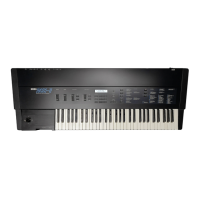■ With additive synthesis, you set the level of each of
128 harmonics (each of which is a simple sine wave
that is a harmonic multiple of the first or fundamental
frequency.) The result is one full cycle of a complex
waveform. This method is useful for making many
naturally occurring waveforms.
Behind this method is the idea that any regular
waveform can be analysed into a series of sine waves of
different levels (a mathematical technique called Fourier
analysis). For example, in a sawtooth wave, we have the
fundamental, the 2nd harmonic at 1/2 the level of the
fundamental, the 3rd harmonic at 1/3 the level of the
fundamental, the 4th harmonic at 1/4 the level of the
fundamental, the 5th harmonic at 1/Sth the level of the
fundamental, and so on.
• Additive synthesis
1st harmonic^
(fundamental)
4th harmonic
Sound is created by
setting the level of
each sine wave and
mixing them all to
gether.
t
I
12Bth harmonic
)
Principle of additive synthesis
Fundamental + 1/2 (the level) 2nd harmonic + 1/3 3rd
harmonic + 1/4 4th harmonic + 1/5 5th harmonic.
Fundamental + 1/2 2nd harmonic + 1/3 3rd
harmonic + 1/4 4th harmonic.
Fundamental + 1/2 2nd harmonic + 1/3 3rd harmonic.
Fundamental + 1/2 2nd harmonic.
Fundamental (1st harmonic)
1/2 2nd harmonic
1/3 3rd harmonic
1/4 4th harmonic
1/5 (the level) 5th harmonic
A s you can see, the more har
monics are included, the closer it
becomes to a true sawtooth wave
form.
31

